July 2002Trading Tip:
Divergence Trading
by Buffy and B-Line chat room
Regular Divergence. Hidden Divergence.
"What a great tool, it really works!" "I see divergences all
over the place and would get chopped to pieces if I traded all the
signals. Just doesn’t work for me!" These are comments
and other variations of them that are heard all the time in the
B-Line chat room. Hopefully, we can clear up some of the
confusion so you will be able to add regular and hidden divergence
successfully to your trading toolbox.
Divergence is a comparison of price to technical
indicators. It can also be a comparison to another symbol or
spread between two symbols. Divergence occurs when what you
are comparing is moving in opposite directions. Divergence can
signal an up coming change in trend, a change of trend in progress
or that a trend should continue. A divergence signal suggests
watching for a trading opportunity in the direction of the
signal. Divergences may continue over many swing highs/lows so
price action should confirm your trade. This can be done in
many ways, some of which are: price making a higher high/low or
lower high/low or price testing the last swing high/low, price
trading past high or low of previous bar, many of which will
correspond with the MACD histogram crossing zero.
Divergence trading can be used on many indicators –
Stochastic, MACD, RSI and CCI to name a few. As with most
indicators, divergence signals in a higher time frame (TF) are going
to indicate a larger move in price. The chart examples are
going to be comparing price with the Stochastic and MACD
indicators. Each chart has the 50EMA (Blue), 200EMA (Red),
9/3/3 Stochastic and the 7/10/5 MACD histogram on it. There
are many other Stochastic and MACD settings that also work for
divergence signals.
Regular divergence (RD) is best used at the test of
a previous high or low, what most traders call a double or triple
top/bottom. It is not uncommon to see 3 or 4 higher highs in
price in an up trend with 3 or 4 lower highs in the indicator or 3
or 4 lower lows in price in a downtrend with 3 or 4 higher lows in
the indicator. This is called 3pt RD or 4 pt RD. This is
the indicator telling you with regular divergence that the trend is
getting weak and the potential for a change of trend is there and to
trade accordingly. To some traders, it might mean to tighten
stops, while others might prepare to exit the trade.
Hidden divergence (HD) is best used in trends for
continuation trades with the trend. A high percentage of
hidden divergence trades will move at least to the last swing
high/low, thereby giving you a way to calculate your risk/reward for
the trade. If there isn’t enough points between the signal and
the last swing high/low, then many traders will usually pass on the
trade. Another warning to pass on the trade signaled by HD is
having RD present for the last 3 highs in an up trend or last 3 lows
in a downtrend which is thereby signaling a possible change of trend
(COT).
Many of you already use regular divergence in your
trading. When a fellow trader, NQoos, shared how he used
regular and hidden divergence in his trading and posted his charts
as the trading day developed, many traders in the B-Line chat room
became aware of hidden divergence (HD). Regular divergence
(RD) used with hidden divergence (HD) can improve your percentage of
winning trades. How much depends on your style of trading.
As long as price is making higher highs and higher
lows, that time frame is considered to be in an up trend. When
price is making lower highs and lower lows, that time frame is
considered to be in a downtrend.
The following two charts are an example of regular
divergence. Just because we see regular divergence when
comparing two highs in an up trend or on a comparison of two lows in
a downtrend, it is not an automatic trade. If the trend is
strong enough, you may only get sideways price action or a one or
two bar retracement before the trend resumes. Regular
divergence can be a tool to answer the question of whether the trend
is gaining or losing momentum.
Regular divergence in an up trend (higher
highs/higher lows) compares the higher highs in price with the highs
in the indicator. Note that both Stochastic and MACD have a
lower high while price has a higher high….a signal the trend is
getting weak.
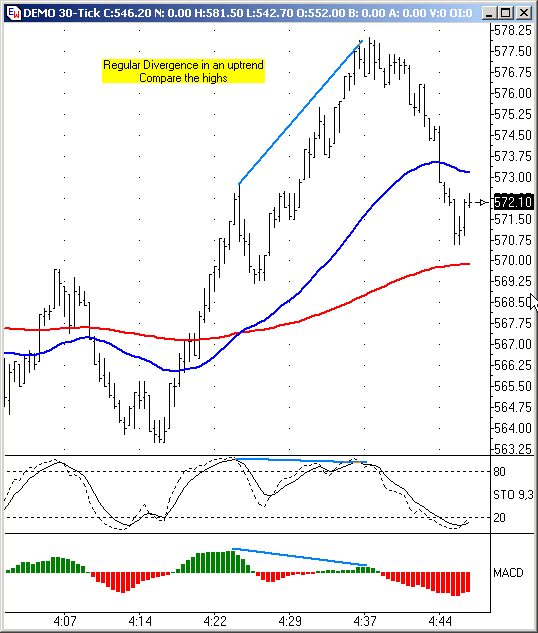
Regular divergence in a downtrend (lower highs/lower lows)
compares the lower lows in price with the lows of the
indicator. Note that both the Stochastic and MACD have higher
lows while the price has lower lows....a signal the trend is getting
weak. This chart also shows an example of 3pt RD – each lower
low in price has a higher low in the MACD. RD can also have
4pt and 5pt divergence before the trend actually changes.
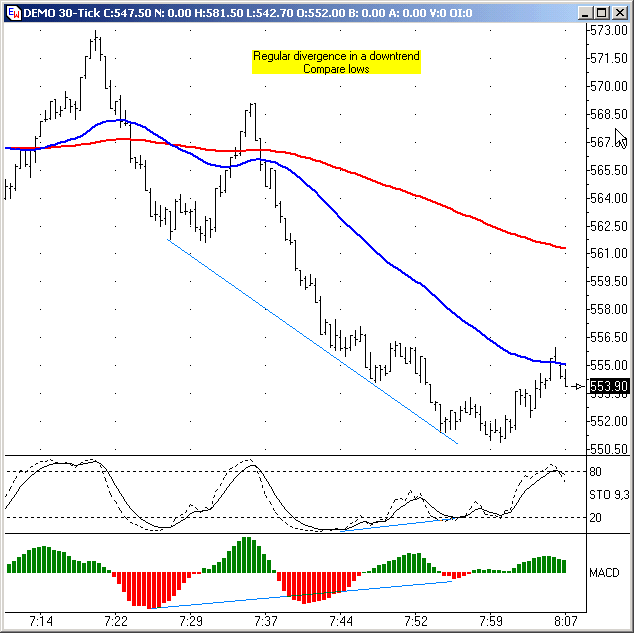
Hidden divergence compares the higher lows (HL) of price in an up
trend with the lower lows (LL) in the indicator and the lower highs
(LH) of price in a downtrend with the higher highs (HH) of the
indicator. Hidden divergence helps to answer the question of
whether the trend is going to continue. The following chart
shows how HD can confirm which flags/retracements are the high
percentage continuation trades to take. When you draw a trend
line (TL) on the indicator you are using, you want the length to
match the TL drawn on price on the chart. Note the price
action entry for many traders corresponds with MACD crossing
zero.

Another time to look for a divergence is after a period of
consolidation or sideways movement in the market that also has a
test of a previous high or low in the consolidation range. The
following chart shows the benefit of drawing trend lines (TL) as
soon as you have the two points to do so (the red arrows on
left). Each touch of the TL by price is a place to check to
see what HD is saying. The test of TL by price about 1:30,
shows an example of how RD can be a warning that the HD signal, if
taken, will not reach the target of the last swing low.
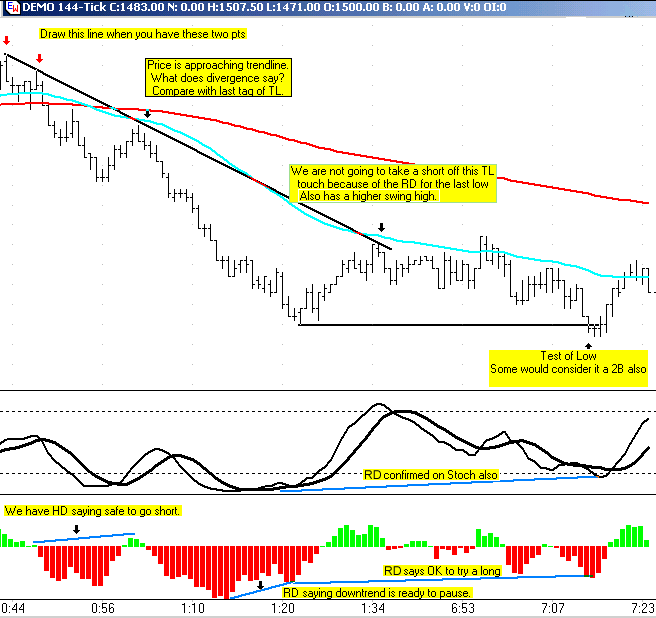
The following chart shows how to use divergences
with trend lines and anticipated MACD cross of zero at the same time
the TL is being broken. Divergence is implying that price will have
the strength behind it to take out the trend line resistance.
Notice the setup started in the higher time frame inserted
chart. Dropping down to a lower time frame enabled us to have
a better entry point with less risk.
The chart shows how divergence signaled two
identical setups for low risk longs on a trend line (TL) break of
the light blue TLs also coinciding with the MACD crossing
zero. The second low risk long also has HD divergence with the
previous low in its favor also. Note that the 3pt regular
divergence shown in the higher time chart in the oval is usually
worth paying attention to.
Also, on this chart many other regular and hidden
divergences have been marked. The divergence trades combined
with trend lines, Fibonacci levels, support, resistance and/or
patterns are higher percentage trades.
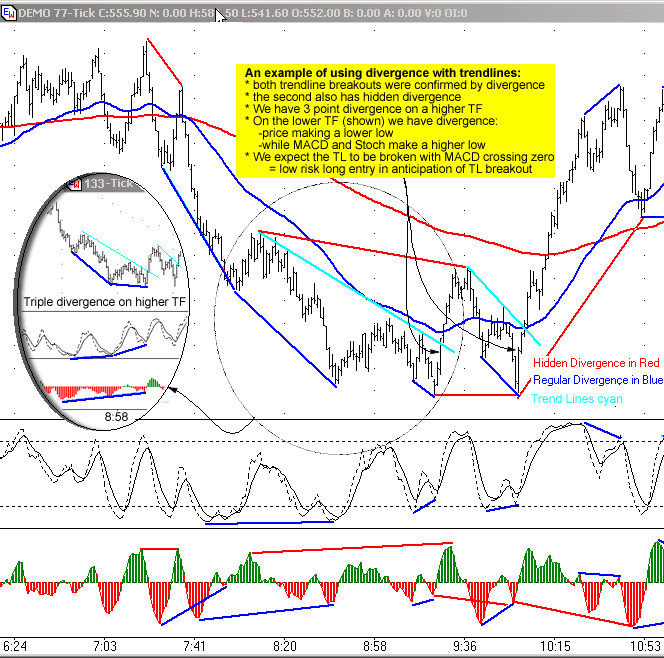
NQoos rules that he uses for divergence trading
system along with many chart examples can be reviewed at http://www.dacharts.com/NQoos.php.
Remember what all those good books say though, "Each trader should
find what works for them." Nothing wrong with taking an idea
from here and an idea from there to make your own system. We
call that the "trading cocktail" in the chat room. But, that
is another article……
Again NQoos, thanks for sharing your way of trading with
divergences with fellow traders in the B-Line chat room! Also,
a big thank you to fellow traders for their constructive suggestions
regarding this.
The Trading Tips newsletter has articles on Stochastic and RSI
divergence that are well worth reading.
Trading Tip:
Divergence Cheat Sheet
by Vaughan Kilpatrick
It’s about higher highs and lower lows. If you find them in
price, but not in the oscillator, you have regular divergence.
If you find them in the oscillator, but not in price, then it’s
hidden divergence.
Higher Highs => Short
Lower Lows => Long
At first this seemed to me like the opposite of common sense, so
I had to think about it for a while. I finally got it that it
means when higher highs or lower lows in either price or an
oscillator aren’t confirmed by the other, then the direction
indicated by the extremes, meaning the higher highs or lower lows,
is weak and is likely to change.
If the higher highs or lower lows are in price but not the
oscillator, then the direction of price is likely to reverse.
This is regular, or classic divergence and can be used as a
confirming indicator for a reversal entry.
Regular divergence describes a price trend change that will
probably happen in the future, albeit shortly. On the other
hand, hidden divergence is a confirming indicator of past price
direction.
We have hidden divergence when we have higher highs or lower lows
in the oscillator but not in price. In this case the
direction indicated by higher highs or lower lows in the oscillator
is contradicted by the price trend. Unlike regular divergence,
where the weakness in price trend is about to lead to a reversal;
here the weakness has already led to a little reversal against the
trend. The hidden divergence implies that this recent
little reversal in price direction will be short-lived and that
price will resume moving in the direction of the trend. This
is exciting because it can confirm a continuation entry,
which is generally much less risky than a reversal entry. What
you have here is the opportunity to enter on a pullback of the
current trend, which you expect to continue based on this and
whatever other indicators you choose. This is trading with the
trend, nice and friendly; however, please heed the following
warning.
Warning: I consider divergence to be an indicator, not
a signal to enter a trade. It would be unwise to enter a trade
basely solely on this indicator as too many false signals are given;
however, on the other hand, I consider it even more unwise to trade
against this indicator.
Thanks to NQoos for sharing his knowledge in the B-Line chat room
and providing so many wonderful examples of divergence in his great
charts posted at http://www.dacharts.com/.
Also thanks to Dave Shedd and Buffy for bringing us all together and
for freely and generously sharing their time and knowledge.

SUMMARY OF FOUR TYPES OF DIVERGENCE
Regular Divergence:
- Higher highs in price and lower highs in the oscillator which
indicate a trend reversal from up to down.
- Lower lows in price and higher lows in the oscillator which
indicate a trend reversal from down to up.
Hidden Divergence:
- Lower highs in price and higher highs in the oscillator which
indicate a confirmation of the price trend which is down.
- Higher lows in price and lower lows in the oscillator which
indicate a confirmation of the price trend which is up.
On the diagram, the diagonal lines represent the trend lines
drawn on a chart showing how each of the four patterns look with
price above and the oscillator below. On the two price lines,
going either from right to left or left to right, the reversal of
the diagonal lines shows the direction to be expected by each
instance of divergence. In each of the four instances of
divergence, when price is headed up, green, chances are good it will
turn down, red, and vice versa.
Trading Tip:
Fibonacci
Relationships
One of the techniques used by Larry
Pesavento is labeling a chart with its Fibonacci
relationships. This daily chart of Intel illustrates the swing
relationships that Larry would identify on the chart.
The 5 sacred ratios he is looking for are 0.618, 0.786, 1.00, 1.272,
and 1.618.
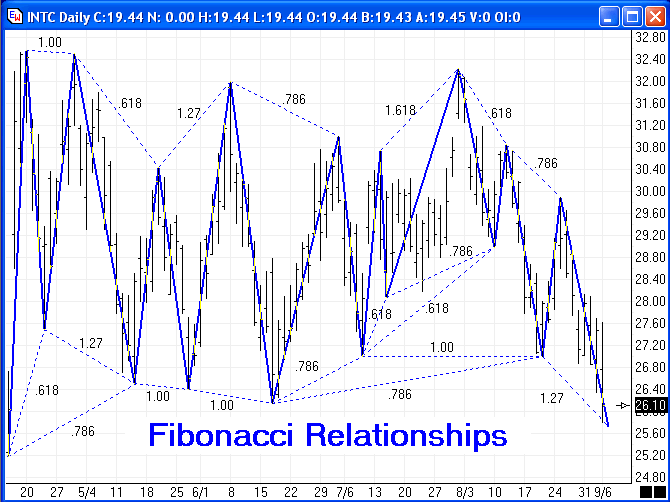
"Intel is one of the most widely held and liquid
stocks in the world and trades over 20 million share per day.
Notice the 17 price swings on the daily chart covering a four month
period. Every swing is related to every other swing by the
Fibonacci summation series of numbers." -Larry
Pesavento |